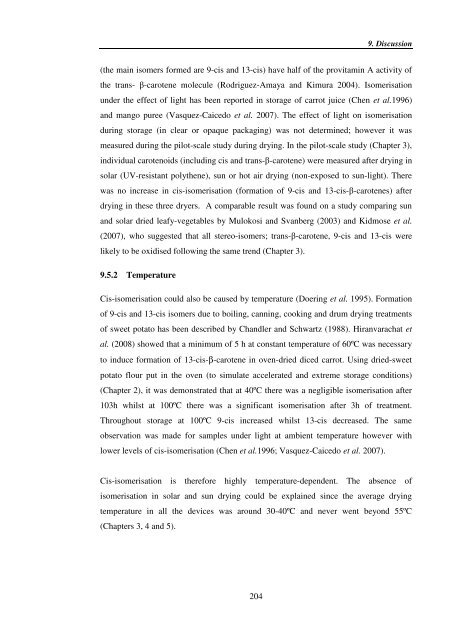Investigating carotenoid loss after drying and storage of
Investigating carotenoid loss after drying and storage of
Investigating carotenoid loss after drying and storage of
You also want an ePaper? Increase the reach of your titles
YUMPU automatically turns print PDFs into web optimized ePapers that Google loves.
204<br />
9. Discussion<br />
(the main isomers formed are 9-cis <strong>and</strong> 13-cis) have half <strong>of</strong> the provitamin A activity <strong>of</strong><br />
the trans- !-carotene molecule (Rodriguez-Amaya <strong>and</strong> Kimura 2004). Isomerisation<br />
under the effect <strong>of</strong> light has been reported in <strong>storage</strong> <strong>of</strong> carrot juice (Chen et al.1996)<br />
<strong>and</strong> mango puree (Vasquez-Caicedo et al. 2007). The effect <strong>of</strong> light on isomerisation<br />
during <strong>storage</strong> (in clear or opaque packaging) was not determined; however it was<br />
measured during the pilot-scale study during <strong>drying</strong>. In the pilot-scale study (Chapter 3),<br />
individual <strong>carotenoid</strong>s (including cis <strong>and</strong> trans-!-carotene) were measured <strong>after</strong> <strong>drying</strong> in<br />
solar (UV-resistant polythene), sun or hot air <strong>drying</strong> (non-exposed to sun-light). There<br />
was no increase in cis-isomerisation (formation <strong>of</strong> 9-cis <strong>and</strong> 13-cis-!-carotenes) <strong>after</strong><br />
<strong>drying</strong> in these three dryers. A comparable result was found on a study comparing sun<br />
<strong>and</strong> solar dried leafy-vegetables by Mulokosi <strong>and</strong> Svanberg (2003) <strong>and</strong> Kidmose et al.<br />
(2007), who suggested that all stereo-isomers; trans-!-carotene, 9-cis <strong>and</strong> 13-cis were<br />
likely to be oxidised following the same trend (Chapter 3).<br />
9.5.2 Temperature<br />
Cis-isomerisation could also be caused by temperature (Doering et al. 1995). Formation<br />
<strong>of</strong> 9-cis <strong>and</strong> 13-cis isomers due to boiling, canning, cooking <strong>and</strong> drum <strong>drying</strong> treatments<br />
<strong>of</strong> sweet potato has been described by Ch<strong>and</strong>ler <strong>and</strong> Schwartz (1988). Hiranvarachat et<br />
al. (2008) showed that a minimum <strong>of</strong> 5 h at constant temperature <strong>of</strong> 60ºC was necessary<br />
to induce formation <strong>of</strong> 13-cis-β-carotene in oven-dried diced carrot. Using dried-sweet<br />
potato flour put in the oven (to simulate accelerated <strong>and</strong> extreme <strong>storage</strong> conditions)<br />
(Chapter 2), it was demonstrated that at 40ºC there was a negligible isomerisation <strong>after</strong><br />
103h whilst at 100ºC there was a significant isomerisation <strong>after</strong> 3h <strong>of</strong> treatment.<br />
Throughout <strong>storage</strong> at 100ºC 9-cis increased whilst 13-cis decreased. The same<br />
observation was made for samples under light at ambient temperature however with<br />
lower levels <strong>of</strong> cis-isomerisation (Chen et al.1996; Vasquez-Caicedo et al. 2007).<br />
Cis-isomerisation is therefore highly temperature-dependent. The absence <strong>of</strong><br />
isomerisation in solar <strong>and</strong> sun <strong>drying</strong> could be explained since the average <strong>drying</strong><br />
temperature in all the devices was around 30-40ºC <strong>and</strong> never went beyond 55ºC<br />
(Chapters 3, 4 <strong>and</strong> 5).






